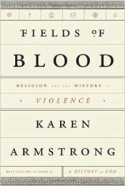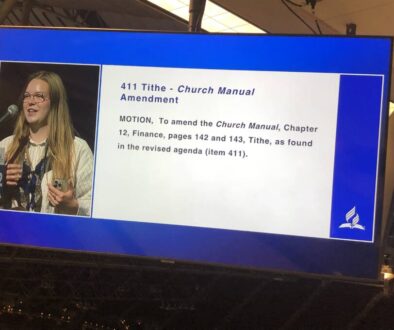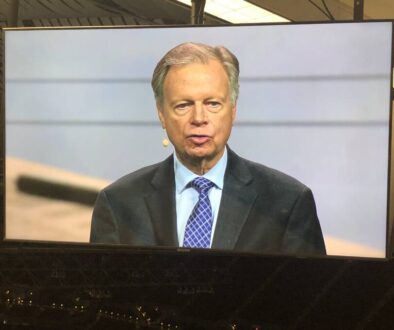BOOK REVIEW: Fields of Blood: Religion and the History of Violence
by Karen Armstrong (Alfred A. Knopf, Copyright 2014)
 Reviewed by Edwin A. Schwisow, June 9, 2015: I grew up in a devout Adventist family saturated with Bible stories and a very clear prime directive that our purpose in life was to export our faith and be found waiting with uplifted arms to receive the Lord in the air, when he appeared.
Reviewed by Edwin A. Schwisow, June 9, 2015: I grew up in a devout Adventist family saturated with Bible stories and a very clear prime directive that our purpose in life was to export our faith and be found waiting with uplifted arms to receive the Lord in the air, when he appeared.
So it was, in 1961, that when an invitation from the General Conference came to move us from Washington state to a mission hospital in South America, we three kids fearfully agreed with our parents that this could be a wonderful adventure (if we survived the dread diseases and harrowing mountains.)
Within this family setting, in years immediately following our move to Bolivia, I came to personally read several versions of the Bible, cover to cover, in both Spanish and English by age 11, and had reached several tentative conclusions (at that rather tender age) about the Bible, as it touched on some of the content of prolific author Dr. Armstrong’s most recent book, Fields of Blood: Religion and the History of Violence.
My first conclusion as a young reader of Scripture was that the Old Testament contains hideously intimate accounts of gruesome killings and mayhem, dismemberments, and corpse desecrations, including depiction of at least some genocide as an absolute godly imperative. The thought occurred to me that maybe I was too young to be reading this bloody material; that my mind, as yet un-blest by adult development, just didn’t perceive the bigger picture of an Old Testament that extolled exotic killings worthy of the mind of Ted Bundy, while claiming to pursue absolute homage and obedience to Jehovah.
I belabor this early experience with the Bible, because I believe one’s viewpoint is very important as we answer prevalent charges in today’s world that “religion is the primary cause of violence throughout recorded history.” In fact, this is the primary stated point of departure of Armstrong’s information-packed book, to analyze this claim and help us contend with such dispiriting charges. Armstrong herself admits that the events of September 11, 2001 in the destruction of the Twin Towers of New York City have contributed to the now-widely spread popular derogation of religion in First-world nations; that far more than their destruction of real estate and lives, the perpetrators of the attack have done far more damage to the reputation of the Abrahamic faiths than to anything else.
The book focuses heavily on the history of the three Abrahamic faiths, though ancient Indian and Chinese traditions are also discussed in the opening chapters. Broadly speaking, Armstrong’s argument is convincing—that religion itself is rarely a causative factor in setting nation against nation in the historical record. She does contend, however, that religion is often employed by leaders to cloak their warlike intent with a moral facade. But at the foundational level, she says, war is the product of a desire to forcibly reallocate resources. Rarely if ever (even in colonial conquests) is religion itself the strongest motivator in the decision to attack and invade.
Among a number of sectors in my own Adventist denomination, I have found individuals who declare that Islam is by nature a bloody religion and that this in and of itself opens the moral door for a Christian nation to attack members of that faith. Armstrong fortuitously wrestles with the question of Islam’s core violence, and suggests strong historical reasons why this is not ultimately true.
That Armstrong herself is a non-believer serves her well in her evaluation of major faiths and their relation to violence. As a lapsed Catholic writer and philosopher, she continues to see religion as a vital essential in the affairs of nations. This is a book that any Adventist with heart kindled to evangelism should consider before launching into debating excursions with members of other faiths. I will close here with an anecdote from my childhood in South America.
One morning word reached us that a convoy of trucks filled with armed men had driven into town on the main highway, intent on sacking and pillaging our town the night before; but that suddenly a white-robed figure had appeared in the middle of the road in front of them and commanded them to turn around and do nothing to harm the town or its Adventist hospital.
The apparition was said to have been about seven feet tall, and that the drivers were so fearful that they wordlessly obeyed the angelic presence, to the letter. The convoy was never seen or heard of again.
The story filled Adventist people with joy, until it became clear that the “angelic presence” had been none other than the exceedingly tall, white-robed leader of the local Catholic diocese, who had donned his flowing Benedictine cassock to stand with pistol in hand to defend the town and all its inhabitants, including Adventists with whom he enjoyed excellent rapport at the local mission hospital.
As might well be expected, the story of the angelic presence that defended our hospital never made it into the Junior Guide or The Primary Treasure. But it taught me at an early age that by and large people of a religious bent tend to honor and uphold one another against the forces of overt evil. Religion rarely contributes to strife, except in the hands of strife-driven people who employ religion as a moral cloak to justify their own rise to power.
Summary: The author demonstrates that the episodes of cruelty and killing through history have had little or no basic religious overlay . . . [and that] an overemphasis on religion’s damage can blind people to non-holy terror. The overall theme of the book is quite simple and can be grasped almost instantaneously; the wealth of the book consists in its nuanced examples and defense of the proposition that ultimately we have far more to fear from selfish institutional adventurism than from the predations of even the most radical religious enthusiasts.




